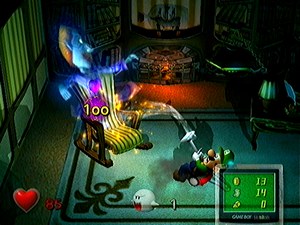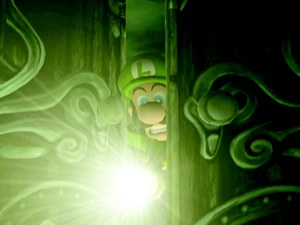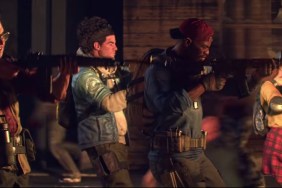Who you gonna call – Luigi?
Losing sucks. Just name your game – football, TV trivia, Super
Monkey Ball – regardless of the stakes or the competition, there’s nothing
worse than being a perpetual second-rate talent. Sure, you can “lose with dignity”
and “learn a valuable lesson,” but wouldn’t it be better just to win right from
the get-go?
No stranger to losing is Luigi, the Roger Clinton of the Nintendo family. Mario has always gotten the girl and the leading roles, while Luigi has been nothing more than a line item clause in the contracts. After all, who else is going to fill in for Player 2?
Now
for the first time ever, Luigi has his name up in lights, starring in Luigi’s
Mansion. How does the gaming world’s most famous second banana do in his
first major solo outing? Not-a bad.
Luigi has received a letter notifying him that he’s won a mansion. And he
hasn’t even entered any contests! Silly Luigi. You don’t see me pounding at
Ed McMahon’s door demanding my millions, do you? (Well, at least not
after the restraining order.) In any case, Luigi quickly discovers that Mario
is lost somewhere in the spooky house, and off Luigi goes to save his fat brother,
for a change.
But as luck would have it, Luigi’s new pad is crawling with ghosts, from the
familiar Boos to an entire family of long-dead spooks. Luigi’s only weapon is
the PolterGust 1000, a modified ghost-sucking vacuum cleaner given to him by
Professor Gadd. And unlike the Ghostbusters, Luigi is very afraid of
them ghosts.
In many ways, the game feels like a primer for your GameCube controller. The
dual analog gameplay familiarizes the player with the giant A button as the
primary action button as well as the wacky new C joystick. C manipulates the
vacuum cleaner’s aim, almost like how a mouse manipulates the aim in a first-person
shooter, only now it’s from a third person point of view.
To capture ghosts, Luigi must first stun them with a flashlight, after which he starts frantically vacuuming away. It isn’t like pulling a combo where the two parts just flow into one another. It takes some time to get used to the decidedly different technique, but eventually it becomes almost second nature. The key word is “almost.” Nonetheless, it’s an original and fun control style.
In addition to nabbing ghosts, Luigi can use his vacuum cleaner to search
for coins or hearts hidden amongst the mansion’s furniture. I don’t know who
programmed his item search animation, though, because it’s disturbing. I wanted
to just search that lamp, not hump it!
Armed with a ‘Game Boy Horror’ device, Luigi can gauge his item collection as well as get readings on his environment. By examining the hearts of the ghosts, clues on how to capture them are revealed. Some ghosts may take a simple timing maneuver. Others may require manipulating other objects in the room.
The bosses provide some of the most fun in the whole game, but sadly, there
are only 4 of them. Lame.
In terms of level design, Luigi’s Mansion plays less like a typical
Mario game and more like a classic Zelda game. The mansion plays like
one expansive Zelda dungeon. Every room in the creepy house is another
crypt with a secret to unlock. Even the treasure chests have similar jewelry
design as the special item chests in Zelda.
 The
The
problem here is that one giant dungeon can get pretty redundant. The Zelda
games had expansive outer worlds to offset the dungeon exploration. With Luigi’s
Mansion, it’s just one room puzzle to the next. Whenever you find a new
key, the room you unlocked is clearly detailed to you in your GBH. The helping
hand of the game is great for a younger audience, but only speeds the game along
for the more experienced gamer.
Indeed, Luigi’s Mansion is a short game, netting less than 10 hours
the first time through the mansion. After you’ve beaten it, you receive a ranking.
The only new option afterward is to play again and collect more cash to boost
your rating. There’s also a ‘hidden mansion’ opened up after beating the game,
but don’t get too excited. It’s the same as the original, but with a stronger
vacuum cleaner.
Graphically, the game is set apart by the brilliant use of lighting. The awesome
candlelight illuminates the cartoon stylings of the game. The ghosts look terrific,
exhibiting a three-dimensionality that extends beyond mere transparency. It’s
hard to describe, but they look a lot like Slimer from the Ghostbusters
movies.
The game also has a nicely developed physics model lurking behind every visual in the game. Your vacuum cleaner affects nearly everything in the environment. You can pull tablecloths out from underneath the table settings. Spray some water in the air, quickly turn on your vacuum cleaner, and watch the water particles get sucked in. For such a cartoony game, the realism is great.
Musically, expect the traditional Mario-esque tunes. Some classic melodies even make a cameo experience. Same goes with the cartoon sound effects, taken from Nintendo’s library of pops and zings. It’s very familiar and comfortable.
Even though big points aren’t being taken off for this, part of a quality
game is the ability to empathize with your on-screen counterpart. Playing Luigi’s
Mansion has made me realize to a bitter extent why Luigi has never been
the leading man. The guy is a goob, from his goofy little trot to the way he
desperately cries “Maaaaario!” like a little retarded kid brother.
Most of all, though, it’s Luigi’s walk animation that bugs me. Why couldn’t they give Luigi more of a lanky walk that conveys his height and his terrified personality without making him look so absolutely wimpy?
Luigi’s Mansion may not be a straight up winner, but I wouldn’t call
his first game a loser at all. The replay value is suspect and the one enormous
dungeon mansion can grow tiring, but the graphics are quite beautiful and the
interesting game mechanics are enjoyable. The game is clearly geared for a younger
audience, but even adult gamers will have some fun. And a note to Luigi – get
yourself some acting lessons and a girlfriend.

-
Beautiful lighting effects
-
Attention to detail
-
Original control style
-
Great bosses...
-
...but only four of them
-
Redundant dungeon game design
-
Short game with little replay







